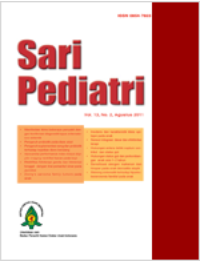Skrining Gangguan Pendengaran pada Neonatus Risiko Tinggi
Sari
Gangguan pendengaran pada masa bayi akan menyebabkan gangguan wicara, berbahasa,
kognitif, masalah sosial, dan emosional. Identifikasi gangguan pendengaran secara dini
dan intervensi yang sesuai sebelum usia 6 bulan terbukti dapat mencegah segala
konsekuensi tersebut. The Joint Committee on Infant Hearing tahun 1994
merekomendasikan skrining pendengaran neonatus harus dilakukan sebelum usia 3 bulan
dan intervensi telah diberikan sebelum usia 6 bulan. Otoacoustic emissions (OAE) dan/
atau automated auditory brainstem response (AABR) direkomendasikan sebagai metode
skrining pendengaran pada neonatus. Pemeriksaan ABR telah dikenal luas untuk menilai
fungsi nervus auditorius, batang otak, dan korteks pendengaran. Pemeriksaan OAE
sebagai penemuan baru dilaporkan dapat menilai fungsi koklea, bersifat non invasif,
mudah dan cepat mengerjakannya, serta tidak mahal.
Kata Kunci
Teks Lengkap:
PDFReferensi
Sokol J, Hyde M. Hearing screening. Pediatr Rev 2002;
:155-62.
Kenna MA. Neonatal hearing screening. Pediatr Clin
North Am 2003; 50:301-313.
Mason JA, Herrmann KR. Universal infant hearing
screening by automated auditory brainstem response
measurement. Pediatrics 1998; 101:221-8.
Yoshinaga-Itano C, Sedey AL, Coulter DK, Mehl AL.
Languange of early and later-identified children with
hearing loss. Peadiatrics 1998; 102:1161-71.
U.S. Preventive Services Task Force. Guidelines from
Guide to Clinical Preventive Services. Newborn hearing
screening. Recommendations and rationale. U.S.
Preventive Services Task Force. Edisi ke-3, 2001.
Sirlan F, Suwento R. Hasil survei kesehatan indera
penglihatan dan pendengaran 1994-1996. DEPKES
RI, 1997.
Watkin PM, Baldwin M, Laoide S. Parental suspicion
and identification of hearing impairment. Arch Dis
Child 1990; 65:846-50.
American Academy of Pediatrics. Joint Committee on
Infant Hearing 1994 position statement. Pediatrics 1995;
:152-6.
American Academy of Pediatrics. Task force on newborn
and infant hearing. Newborn and infant hearing loss:
detection and intervention. Pediatrics 1999; 103:527-30.
Kennedy CR, Kimm L, Dees DC, Evans PIP, Hunter
M, Lenton S, et al. Otoacoustic emissions and auditory
brainstem responses in the newborn. Arch Dis Child
; 66:1124-9.
Norton SJ. Emerging role of evoked otoacoustic emissions
in neonatal hearing screening. Am J Otol 1994;
:4-11.
Cunningham M, Cox EO. Hearing assesment in infant
and children: Recommendations beyond neonatal
screening. Pediatrics 2003; 111:436-440.
Joint Committee on Infant Hearing. Year 2000 position
statement: Principles and guidelines for early hearing
detection and intervention programs. Pediatrics
; 106:798-817.
Davis A. Childhood hearing impairment: public health
perspective. Dalam: McCormick B, penyunting. Paediatric
Audiology 0-5 years. Edisi ke-2. London: Whurr
Publishers, 1993. h. 22-25.
Mills JH, Adkins WY. Anatomy and physiology of hearing.
Dalam: Bailey BJ, Johnson JT, Kohut RI, Pillsbury
HC, Tardy ME, penyunting. Head and neck surgery
otolaryngology. Edisi ke-2. Philadelphia: JB Lippincott
company, 1993. h. 1441-61.
Billings KR, Kenna MA. Causes of pediatric sensorineural
hearing loss. Yesterday and today. Arch Otolaryngol
Head Neck Surg 1999; 125:517-21.
Bonfils P, Francois M, Avan P, Londero A, Trotoux J,
Narcy P. Spontaneous and evoked otoacoustic emissions
in preterm neonates. Laryngoscope 1992; 102:182-6.
Universal Neonatal Hearing Screening. Scottish Implementation,
Didapat dari: http://www.show.scot.nhs.uk
Lonsburry-Martin BL. Introduction to accoustic emissions.
Am J Otol 1994; 15:1-3.
Cox LC. Otoacoustic emissions as a screening tool for
sensorineural hearing loss. J Pediatr 1997; 130:685-6.
Wessex Universal Neonatal Hearing Screening Trial
Group. Controlled trial of universal neonatal screening
for early identification of permanent childhood hearing
impairment. Lancet 1998; 352:1957-64.
Callison DM. Early identification and intervention of
hearing-impaired infants. Audiologic evaluation of hearing-
impaired infants and children. Otolaryngol Clin
North Am 1999; 32:1009-18.
Chang KW, Vohr BR, Norton SJ, Lekas MD. External
and middle ear status related to evoked otoacoustic emissions
in neonates. Arch Otolaryngol Head Neck Surg
; 119:276-82.
Sininger YS, Abdala C. Otoacoustic emissions for the
study of auditory function in infants and children.
Dalam: Berlin CI, penyunting. Otoacoustic Emissions
Basic Science and Clinical Applications.Edisi ke-1. San
Diego: Singular Thomson Learning,1998. h. 105-26.
Balkany T, Telischi FF, McCoy MJ, Lonsbury-Martin
BL, Martin GK. Otoacoustic emissions in otologic practice.
Am J Otol 1994; 15:29-38.
Dunkley C, Farnsworth A, Mason S, Dodd M, Gibbin
K. Screening and follow up assessment in three cases of
auditory neuropathy. Arch Dis Child 2003; 88:25-6.
Windmill IM. Universal screening of infants for
hearing loss: further justification. J Pediatr 1998;
:318-9.
Elliott C, Lightfoot G, Parker D, Stapells D, Stevens J,
Sutton G, et al. Neonatal hearing screening and assesment.
Automated auditory brainstem response information and
guidelines for screening hearing in babies. Didapat
dari: http://www.nhsp.info/documents/work
Hendarmin H, Suwento R. Gangguan pendengaran pada
bayi dan anak. Dalam: Soepardi EA, Iskandar N,
penyunting. Buku Ajar Telinga-Hidung-Tenggorok Kepala
Leher. Jakarta: Balai Penerbit FKUI, 2001. h. 28-32.
DOI: http://dx.doi.org/10.14238/sp6.4.2005.149-54
Refbacks
- Saat ini tidak ada refbacks.
##submission.copyrightStatement##
##submission.license.cc.by-nc-sa4.footer##
Email: editorial [at] saripediatri.org


Sari Pediatri diterbitkan oleh Badan Penerbit Ikatan Dokter Anak Indonesia
Ciptaan disebarluaskan di bawah Lisensi Creative Commons Atribusi-NonKomersial-BerbagiSerupa 4.0 Internasional.




